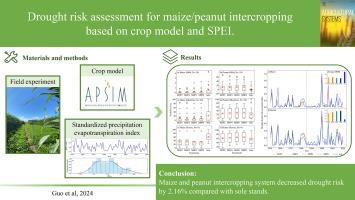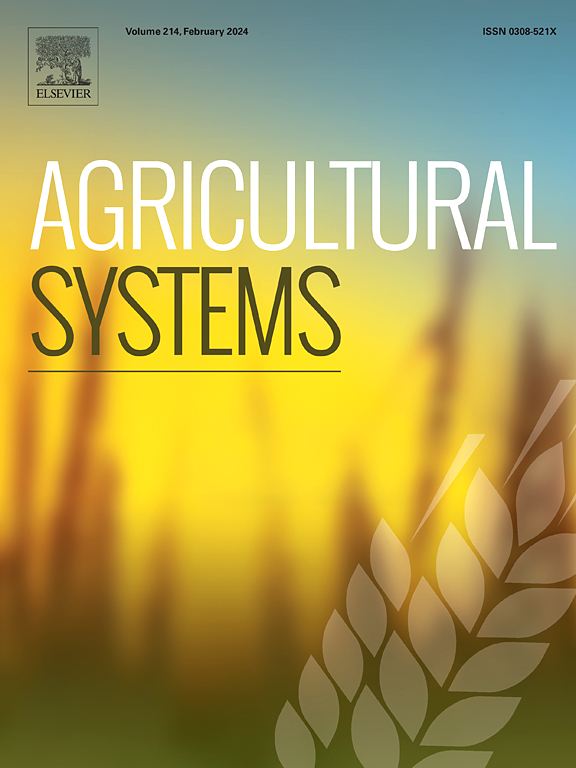基于作物模型和 SPEI 的玉米/花生间作干旱风险评估
IF 6.1
1区 农林科学
Q1 AGRICULTURE, MULTIDISCIPLINARY
引用次数: 0
摘要
背景在气候变化的影响下,干旱频繁发生,尤其对雨水灌溉的农业地区构成巨大威胁。由于间作物种的种间互补性和水资源利用效率的提高,间作系统作为缓解干旱压力的一种适应措施得到了推广。方法 农业生产系统模拟器(APSIM)被广泛用于评估气候变化对作物产量的潜在影响。在本研究中,我们利用 APSIM 模型,结合条状间作作物的光照截获模型,量化了 1951 年至 2020 年间四种玉米/花生条状间作处理中作物干旱造成的产量损失。结果与结论根据干旱风险评估指数,在所有测试行配置中,间作与单株相比干旱风险降低了 2.16%。在这项研究中,我们发现玉米/花生条间作在过去 35 年中降低了 5.7 % 的干旱风险,超过了之前 35 年的水平。我们的结论是,间作可以作为雨水灌溉农业的一种风险管理策略,在四种测试的间作系统(包括 2 行玉米和 2 行花生、4 行玉米和 4 行花生、6 行玉米和 6 行花生以及 8 行玉米和 8 行花生)中,2 行玉米和 2 行花生的条状间作效果最好。意义我们的长期模拟证实,在全球气候变化的情况下,间作可以降低雨养农业的干旱风险。总之,本研究介绍了生态系统生物多样性中的干旱风险量化方法。然而,仍需要进一步的田间试验来探索资源竞争对间作系统性能的影响。来自其他地点的更多数据将增强未来研究的空间代表性。未来的研究还应结合作物生理学和生态学理论,从作物机理的角度研究间作的抗旱性。本文章由计算机程序翻译,如有差异,请以英文原文为准。

Drought risk assessment for maize/peanut intercropping based on crop model and SPEI
Context
Drought occurs frequently under climate change and is considered a huge threat especially for the rain-fed agricultural region. Intercropping systems are promoted as an adaptation to mitigate drought stress due to the interspecific complementarity of intercropped species and improved water use efficiency.
Objective
The aim of this study was to select a drought risk assessment model for maize/peanut strip intercropping to quantitatively evaluate whether intercropping can mitigate drought risk compared to sole stands, using the daily Standardized Precipitation Evapotranspiration Index (SPEI) for analysis.
Methods
The Agricultural Production Systems Simulator (APSIM) is widely used to assess the potential impacts of climate change on crop yield. In this study, we employed the APSIM model, integrated with a light interception model for strip intercrops, to quantify yield losses caused by crop droughts in four maize/peanut strip intercropping treatments from 1951 to 2020. Additionally, we developed physical vulnerability curves and the corresponding drought hazard indices.
Results and conclusions
Based on the drought risk assessment index, intercropping decreased drought risk by 2.16 % compared with sole stands across all testing row configurations. In this study, we found that maize/peanut strip intercropping reduced drought risk by 5.7 % over the past 35 years, outperforming the previous 35 years. We concluded that the intercropping could be a risk management strategy in rain-fed agriculture, and among the four tested intercropping systems, including 2 rows of maize and 2 rows of peanut, 4 rows of maize and 4 rows of peanut, 6 rows of maize and 6 rows of peanut, and 8 rows of maize and 8 rows of peanut, strip intercropping with 2 rows of maize and 2 rows of peanut was the best.
Significance
Our long-term simulations confirmed that intercropping could reduce drought risk in rain-fed agriculture under global climate change. Overall, this study introduces drought risk quantification methods in ecosystem biodiversity. However, further field experiments are still needed to explore the impact of resource competition on intercropping system performance. Additional data from other locations will enhance the spatial representation in future research. Future research should also combine crop physiology and ecological theories to study intercropping drought resistance from a crop mechanism perspective.
求助全文
通过发布文献求助,成功后即可免费获取论文全文。
去求助
来源期刊

Agricultural Systems
农林科学-农业综合
CiteScore
13.30
自引率
7.60%
发文量
174
审稿时长
30 days
期刊介绍:
Agricultural Systems is an international journal that deals with interactions - among the components of agricultural systems, among hierarchical levels of agricultural systems, between agricultural and other land use systems, and between agricultural systems and their natural, social and economic environments.
The scope includes the development and application of systems analysis methodologies in the following areas:
Systems approaches in the sustainable intensification of agriculture; pathways for sustainable intensification; crop-livestock integration; farm-level resource allocation; quantification of benefits and trade-offs at farm to landscape levels; integrative, participatory and dynamic modelling approaches for qualitative and quantitative assessments of agricultural systems and decision making;
The interactions between agricultural and non-agricultural landscapes; the multiple services of agricultural systems; food security and the environment;
Global change and adaptation science; transformational adaptations as driven by changes in climate, policy, values and attitudes influencing the design of farming systems;
Development and application of farming systems design tools and methods for impact, scenario and case study analysis; managing the complexities of dynamic agricultural systems; innovation systems and multi stakeholder arrangements that support or promote change and (or) inform policy decisions.
 求助内容:
求助内容: 应助结果提醒方式:
应助结果提醒方式:


